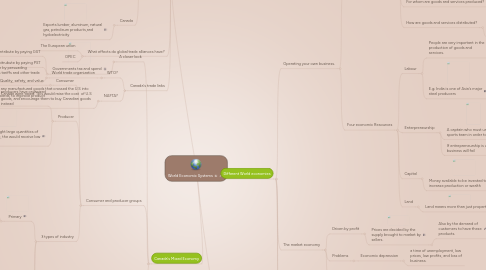
1. Canada's Mixed Economy
1.1. A closer look
1.1.1. Governments tax and spend
1.1.1.1. We contribute by paying GST
1.1.1.2. We conitrubute by paying PST
1.2. Consumer and producer groups
1.2.1. Consumer
1.2.1.1. Quality, safety, and value
1.2.2. Producer
1.2.2.1. Farmers and producers have organized 'marketing boards' to improve product quality
1.2.2.1.1. Marketing board- created to promote their product
1.2.2.2. e.g; if a farmer brought large quantities of eggs/milk to market, the would receive low prices
1.2.3. 3 types of industry
1.2.3.1. Primary
1.2.3.1.1. the collecting of raw materials for use in industry
1.2.3.2. Secondary
1.2.3.2.1. manufacturing and construction activities
1.2.3.3. Teritary
1.2.3.3.1. providing of sevices, such as customer support, distribution, or retailing
1.3. Technological change
1.3.1. Today we have more advanced technology
1.3.1.1. technology- mechanical arts and sciences to produce goods
1.3.1.2. microchip- tiny integrated circuit
1.3.1.3. high technology- equipment and methods based upon computers, robotics, and space research
1.3.2. new technologies
1.3.2.1. computerized mining
1.3.2.1.1. controls mining using joysticks
1.3.2.2. precision farming
1.3.2.2.1. yield montior and a GPS unit are attached to a combine
1.3.2.3. high-tech farming
1.3.2.3.1. grabs the tree and cuts it at ground level
2. Canada's world trade
2.1. What is balance of trade?
2.1.1. Internation carriers
2.1.1.1. supertankers
2.1.1.2. container freight
2.1.1.3. electric power lines
2.2. Top traders
2.2.1. The United States
2.2.1.1. Many natural resources & huge agricultural production
2.2.1.2. Wheat exports are the largest in the world
2.2.2. Germany
2.2.2.1. Highest exports
2.2.2.2. high-quality manufactured products
2.2.3. China
2.2.3.1. wide range of natural resources
2.2.4. Japan
2.2.4.1. industrial and technological leader
2.2.5. United Kingdom
2.2.5.1. oil and natural gas
2.2.6. Canada
2.2.6.1. Exports lumber, aluminum, natural gas, petroleum products,and hydoelectricity
2.3. What effects do global trade alliances have?
2.3.1. The European union
2.3.2. OPEC
2.4. Canada's trade links
2.4.1. WTO?
2.4.1.1. World trade organization
2.4.1.1.1. promotes free trade by persuading countries to abolish tariffs and other trade barriers
2.4.2. NAFTA?
2.4.2.1. any manufactured goods that crossed the U.S into Canada were taxed. This would raise the cost of U.S goods, and encourage them to buy Canadian goods instead
3. Choosing between the two is a hard decision.
3.1. Communities want jobs & growth, but the damage done to the environment can have long-term affects on everyone.
3.1.1. E.g; if they had to make new buildings they would have to dig up everything in that area. It would employ many people, however it would have long-term damage.
4. Different World economies
4.1. Operating your own business.
4.1.1. The 5 economic questions:
4.1.1.1. Who produces goods and services?
4.1.1.1.1. artists, farmers, dentists and electricians
4.1.1.2. What goods and services are produced?
4.1.1.2.1. geography often determines which goods can be provided and what services are needed.
4.1.1.3. How are goods and services produced?
4.1.1.3.1. technology
4.1.1.4. For whom are goods and services produced?
4.1.1.4.1. the needs of services
4.1.1.5. How are goods and services distributed?
4.1.1.5.1. trucks for large quanities
4.1.2. Four economic Resources
4.1.2.1. Labour
4.1.2.1.1. People are very important in the production of goods and services.
4.1.2.1.2. E.g; India is one of Asia's major steel producers
4.1.2.2. Enterpreneurship
4.1.2.2.1. A captain who must unify a sports team in order to win.
4.1.2.2.2. If entrepreneurship is weak; the business will fail
4.1.2.3. Capital
4.1.2.3.1. Money available to be invested to increase production or wealth
4.1.2.4. Land
4.1.2.4.1. Land means more than just property
4.2. The market economy
4.2.1. Driven by profit
4.2.1.1. Prices are decided by the supply brought to market by sellers.
4.2.1.1.1. Also by the demand of customers to have these products.
4.2.2. Problems
4.2.2.1. Economic depression
4.2.2.1.1. a time of unemployment, low prices, low profits, and loss of business.
4.2.3. Profit or environment?
4.3. The traditional economy.
4.3.1. Hunting and gathering.
4.3.1.1. Back then, they would organize specific roles in order to supply food.
4.3.1.1.1. Hunting, fishing, and farming
4.3.1.1.2. The kill was shared.
4.3.2. Subsistence agriculture.
4.4. The command economy
4.4.1. Military spending.
4.4.1.1. makes decisions about production and distribution of goods and services
4.4.1.1.1. choosing between the two was a hard decision
4.4.2. Communist economies
4.4.2.1. cuba
